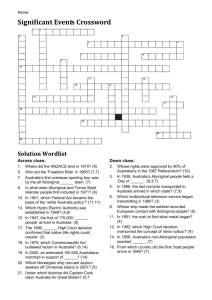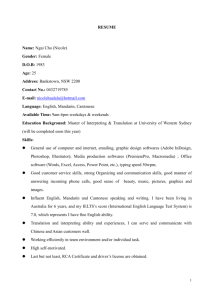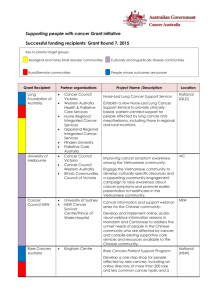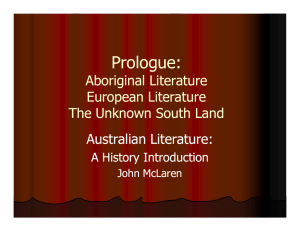The Aboriginal and Torres Strait Islander Flags
advertisement
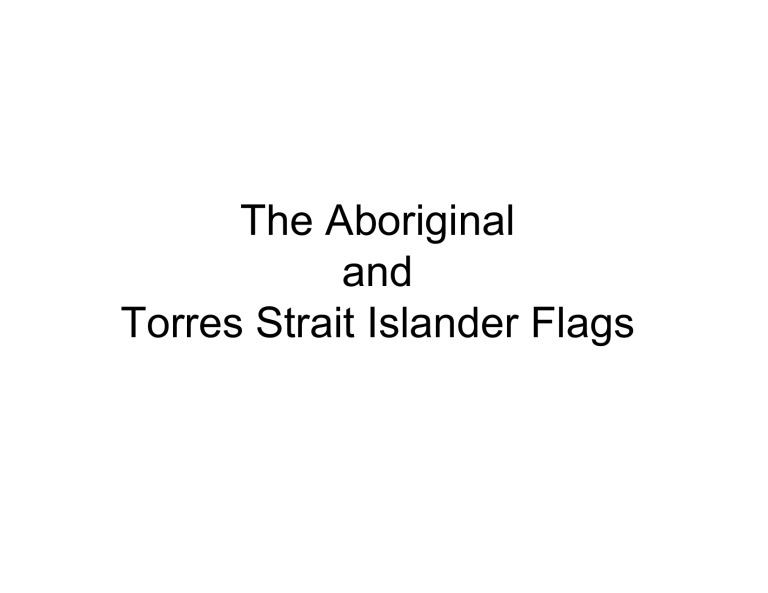
The Aboriginal and Torres Strait Islander Flags The Aboriginal Flag • • • • official flag, designed by an artist and an Aboriginal Harold Thomas in 1971 a symbol for modern Aborigines in their fight for land rights and equality • • • Black àthe colour of the people. Red à the land and for the blood that has been shed since the European invasion. Yellow à the sun, the life-giving source uniting both the land and the people. First flown in 1972 at the Tent Embassy in Canberra. Flown by both Aboriginal and nonAboriginal people In 1994 the Government giving the flag legal recognition On 14 July 1995, Governor General of Australia, William Hayden proclaiming it to be a "Flag of Australia" under section 5 of the Flags Act 1953 • • • official flag, designed in 1992 by Bernard Namok recognised by the Aboriginal and Torres Strait Islander Commission in June 1992. granted under the Flags Act 1953, by proclamation on 14 July 1995 • the green panels at the top and the bottom à the land • the blue panel in the centre à the waters /the ocean of the Torres Strait • the thin black stripes between the green and blue panels à their skin color • the white five-pointed star at the centre à the five major island groups • the white dhari (dancer's headdress) around it à white à peace Lesson III: European Discovery & the Colonization of Australia Before the Europeans l l l The Solo Man & Visitors from PNG Admiral Cheng Ho of the Ming Dynasty: the earliest explorers After the end of the 19th C, the Macassans from South Sulawesi arriving at the Arnhem Land and Kimberley for the sea slug trepang. These visits were finally stopped in 1907 because of their threat to English pearling interests. The Earlier European Explorers l In 1606 - Duyfken, captained by Willem Janszoon, to search for “gold & riches" somewhere in the Spice Islands region. Leaving from Banda (Indonesia) & reaching the Cape York Peninsula and charting some 320 km of the coastline, which he thought to be a southerly extension of New Guinea (an island off the coast of New Guinea) to be named “Nieu Zelandt” l l l 1607 Luis Vaez de Torres, Spanish navigator sailing with Pedro Fernandez de Quiros in search of Terra Australis Incognita, the mythical "great south land," and claiming it for Spain and the Church 1616 Dirk Hartog, the first European to have landed on the western coast of Australia 1642 Abel Janszoon Tasman, Ducth navigator, discoverer Tasmania (which he named Van Diemen's Land after Anthony van Diemen, Governor-General of the Dutch East Indies, called the north, west and south coast of Australia New Holland l l 1688 William Dampier, English navigator, explorer, writer & pirate landing in the north-western Australia 1770 James Cook, arriving at Botany Bay, naming the eastern part New South Wales & presenting it as the Crown land to King George III of England The First British Establishment of Colony 1788 Captain Arthur Phillip , (the 1st Governor of NSW from 1788 – 1792): Leaving England on 13th May 1787 l The First Fleet, between 18 & 20 Jan. 1788 9 ships & 2 Naval vessels ("Syrius" and "Supply" ) with about 1, 350 people (759 convicts, & their Marine guards, some with families, and a few civil officers, now acknowledged as the Founders of Aust.) arriving at Botany Bay l l l l 48 convicts & crew died during the voyage Moving north at Camp Cove, Port Jackson on 26 Jan. 1788 (later known as Australia Day) to establish the first penal colony The Second Fleet (known as the ‘Death Fleet’), 3 June, 1790 the "Lady Juliana", the first of the ships with 225 female convicts sighted & on 20 June followed on 20th June by the "Justinian", 278 convicts & crew died Law and Land in NSW l l 1788—1823 à NSW was a penal colony, although free settlers starting to arrive in 1793 1823, a NSW parliament established by setting up a Legislative Council & a Supreme Court (seen with the establishment of NSW criminal and civil courts but land ownership by the indigenous people was only dealt in the mid—1830s) l l l l 1861, the free selection of Crown land in NSW: any person permitting to select up 320 acres on the condition of paying a deposit & living on the land for three years but Abs were limited to use the Crown lands except pastoral lands. Effects: conflicts between squatters & the selectors, encouraging bushranging Phillip founding a system of labour Who were the convicts? ‘Ticket of Leave’ Lesson II The Original Australians (pp. 10—17) A. Aboriginal People n n n n About 1 ½ % of the total population Rapid decrease after 1788: warfare & diseases Their past way of life seen as ‘primitive’ & thus belonging to inferior (‘stone age’) culture associated with the image of ‘naked hunters’ & ‘food-gatherers’ (semi-nomadic) à social Darwinism Their lives today as the Whites’ & living in the ‘native title’ Aboriginal Elders & Flag B. Torres Strait Islanders n n n Descent of Papua New Guineans Farmers: cultivating the land Declining population since 1606: diseases & battles C. History Pre-1788 n n n n n The Dreamtime (Alcharinge): Ab religious beliefs Central to this à their ancestral creative beings who shaped the land & created plants, reptiles, insects, fishes, birds & people The ancestors emerging from the heavenly world journeying across Aust in Dreamtime Retiring to the sea, undergrounds & heavens Still intervene in the lives of the people & animals through the performance of a cycle of rituals n n Scientists à Ab having occupied in Aust for 45,000 to 50,000 Ab believed from South East Asia by sea (less than 100 kms) D. Australia Bound (1400—1788) n Admiral Cheng Ho, 7 voyages between 1405 & 1432, landing near Darwin in 1432 Lesson IV States and Territories of Australia • New South Wales (NSW) • Sydney • Queensland (QLD) • Brisbane • South Australia (SA) • Adelaide • Tasmania (TAS) • Hobart • Victoria (VIC) • Melbourne • Western Australia (WA) • Perth • Australian Capital Territory (ACT) • Canberra • Northern Territory (NT) • Darwin Entity Head of Ex’ve Head of Gov’ment Upper House of Parl’ment Lower House of Parl’ment Aust’lia Gov’norGeneral Prime Minister Senate House of Rep’tives Sen’tr MHR Leg’tive Assembly MLC MLA None MP NSW VIC QLD SA TAS WA ACT NT G O V E R N O R Chief Minister Adm’tor P R E M I E R Chief Minister Leg’tive Council Abolished (1922) Leg’tive Council None Member of Parl’ment House of Assembly MHA MLC Leg’tive Assembly None MLA • Queen of Britain à Queen of Aust’lia represented by the governor-general • The governor-general is appointed by the Queen of Britain/England on the advice of/nominated by the Prime Minister • The state governors are appointed by the governor-general on the advice of /nominated by the elected the premiers • Until the 1960s: - Distinguished Englishmen à Liberal governments (conservatives à British imperial loyalty) - Australians à Labor governments (left wing à Aust’an nationalist sentiment) • Each state, except Qld which abolished its upper house, has a bicameral legislature • The leader of the winning party: - prime minister of the federal government commissioned by the governor-general • premier of the state commissioned by the governor • Each state has its own police & judicial system • Judges, magistrates & other public officials are appointed for life. • Two-party system of government: Labor (the radical/leftist) & nonLabor (a conservative grouping of parties) Lesson I: The Commonwealth of Australia • • • • • National Anthem :Advance Australia Fair Capital :Canberra Largest City :Sydney Official Language: English (de facto) Government : Parliamentary Democracy (Federal Constitutional Monarch) • Head - Executive à Queen Elizabeth II (Represented by Governor-General) - Government à Prime Minister • Independence from the United Kingdom 1 Jan. 1901 • • • • • Currency: Australian Dollar ($ AUD) Internet: .au Calling Code: +61 The oldest but newest found continent Borders: - North – Indonesia; East Timor & Papua New Guinea - South – the South Pole - North-East – the Solomon Islands, Vanuatu & New Caledonia - South-East – New Zealand People • Indigenous: the Aborigines & Torres Straight Islanders (inhabited for more than 42,000 years) • Visitors from the north (the Macassan fishermen, the Chinese explorers) • The European explorers - The British led by Capt. Cook in (1770) claming the eastern half (NSW) & led by Capt. Phillip (26 Jan. 1788: Australia Day) as Penal Settlements Etymology • ‘Australia’ à Australis (Latin) à southern • Legend à medieval “Geography” à Terra australis incognita à “unknown land of the south” • 1625 by Master Hakluyt published in Hakluytus Posthumus • 1638 by Dutch officials in Batavia (Australische, adj.) • 1693 by French novelist Gabriel de Foigny (Jacques Sadeur) • 1771 by Alexander Dalrymple • 1793 by George Shaw & Sir James Smith • 1814 popularized by Matthew Flinders in A Voyage to Terra Australis • 12 Dec. 1817 recommended to be adopted by the Colonial Office by Gov. Lachlan Macquarie of NSW • 1824 the British Admiralty agreed to officially adopt ‘Australia’ for the continent Geography • Total area 7,741,22o km2 • The Great Barrier Reef (2,000 km2) – a short distance off north-east coast of Queensland • Mount Augustus (WA) the world’s largest monolith • Mount Kosciuszko (2,228 ms) on the Great Dividing Range – the highest mountain on the Australian mainland • The Uluru/Ayer Rock (10 kms) • Mostly desert/semi-arid Religion & Culture • no state religion • Based on the 2006 census mostly identified as Christian (26% Roman Catholic, 19% Anglican); non-Christian followers (5%); non-religion including nontheistic beliefs—humanism, atheism, agnosticism, & rationalism (19%); no response (12%) • The main stream: Anglo-Saxon National Symbols • Coat of Arms of Australia - Initially granted by King Edward VII on May 7, 1908 - the current version granted by King George V on Sept. 19, 1912. Floral Emblem: Golden Wattle (Accacia pycnantha) • Featured on the coat-ofarm • Proclaimed in Sept. 1, 1988 (the Wattle Day) Australian Flag • blue with the Union Jack, a large seven-pointed star (a common wealth star), & a representation of the Southern Cross constellation (one small five-pointed star & four larger seven-pointed stars)



